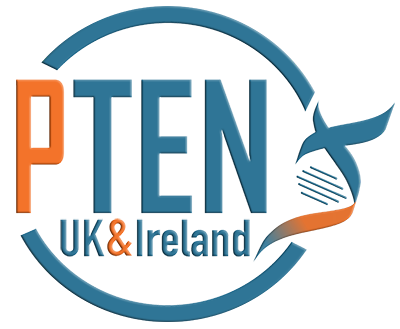About PHTS
PTEN Hamartoma Tumour Syndrome, (PHTS or PTEN syndrome for short) a rare condition caused by a change in the genetic code in the PTEN gene. You might hear other names including Cowden Syndrome (CS) and Bannayan Riley Ruvulcaba Syndrome (BRRS) being used. These were described in the years before genetic testing. They were brought under the umbrella term PHTS after the genetic cause in the same gene was found.
PHTS is thought to affect around 200-300 people in the UK, although the exact number of people with this diagnosis is not known.
The change in the genetic code can be inherited from parent to child, or it can happen spontaneously for the first time in a person. This is called a de novo variant.
People with PHTS usually have a big head (macrocephaly). They sometimes have developmental delay, autism, problems affecting their skin including unusual pigmentation and wart-like lesions, fatty lumps called lipomas or overgrowth of blood vessels (vascular growths or malformations).
People with PHTS are at risk of developing cancers of the breast, thyroid, kidney (renal), bowel, womb lining (endometrial) and skin earlier in their lifetime than the general population. For this reason, regular surveillance tests to try to identify these different cancers is recommended.
Sometimes referred to by its older classifications of Cowden Syndrome (CS) or Bannayan Riley Ruvulcaba Syndrome (BRRS), these syndromes (collection of symptoms) were first identified in the years before the development of genetic testing. Following the discovery that these different conditions were caused by the same gene, they were amalgamated under one name; PHTS or PTEN Hamartoma Tumour Syndrome.
There is a wide range of symptoms associated with the condition which can vary considerably in severity. When recognised in children it can account for issues such as a big head (macrocephaly) , developmental delay, and autism. There is an increased risk of certain types of cancer in adults. People with the condition may have other problems affecting their skin including unusual pigmentation and wart-like lesions. Some people have fatty lumps called lipomas or overgrowth of blood vessels (arterio-venous malformations).
If you are waiting for a diagnosis, are newly diagnosed, or just have suspicions, please take a look at our “New to PHTS” page.
More detailed information can be found on our “On Diagnosis” page.
There is no current treatment or cure. Patients are managed according to their symptoms. Doctors will discuss appropriate cancer surveillance for each person.
Research is ongoing to try to understand the variability and to try to identify treatments and therapies. More information can be found on the PTEN Research Foundation website – www.ptenresearch.org.
